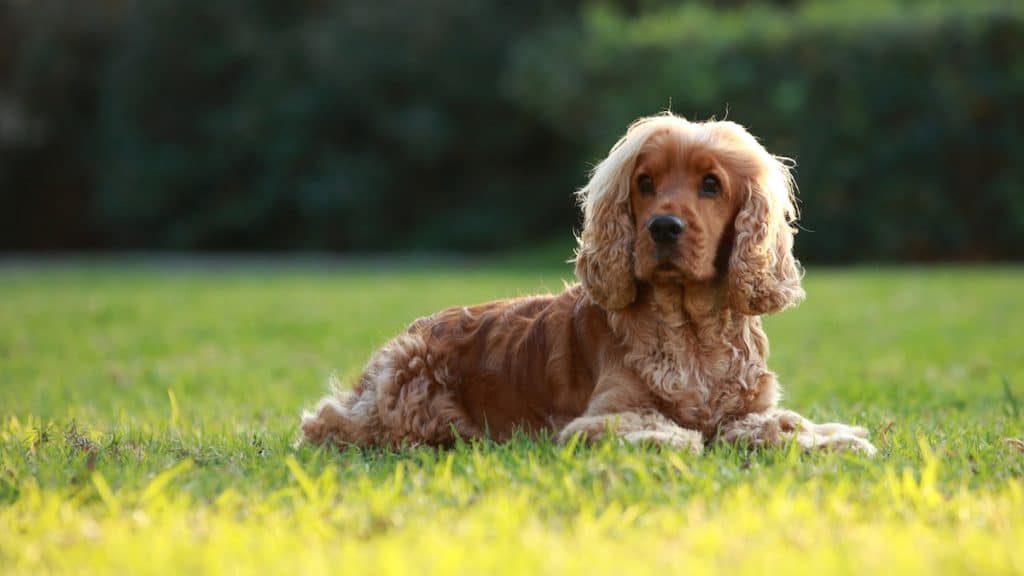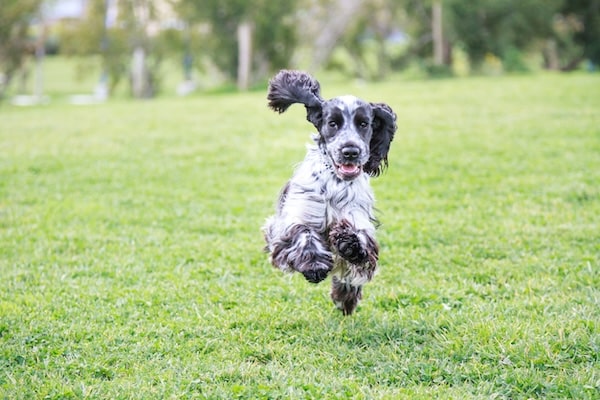
English Cocker Spaniels are a joyful, gentle breed with a sweet temperament that makes them popular among families with children. These affectionate dogs form strong bonds with their humans, earning them a reputation as “Velcro dogs.”
A beautiful breed, the English Cocker Spaniel has large, expressive eyes and long, feathered ears. These dogs are so cute and amiable that they often appear in pop culture as the ideal family dog, as seen in Lady from Lady and the Tramp.
As active sporting dogs, these affectionate pups are no couch potatoes, and they enjoy playtime, brisk walks, and games of fetch. Bred to be hunters, these dogs get their name from their job: flushing out game birds, like woodcock, from dense cover.
Read on to see if this merry breed might just be the dog of your dreams.
Key Breed Characteristics and Facts
The average adult English Cocker Spaniel stands at approximately 15 to 17 inches, with females slightly shorter.
English Cocker Spaniels weigh between 26 and 34 pounds when fully grown. Females are slightly smaller than males.
According to the American Kennel Club, English Cocker Spaniels belong to the sporting group of dogs, which includes dogs bred for hunting.
English Cocker Spaniels come in a variety of colors, most commonly red, black, golden, and liver, which is akin to the color of a Chocolate Lab. However, there are other coat colors, such as blue roan, liver roan, lemon roan, and very rarely, sable.
Despite having a double coat, these dogs are only moderate shedders.
These dogs are known for being energetic outside and chill at home. They’re happiest with regular exercise, activities that stimulate their minds, and quality time with the humans they love.
Some English Cocker Spaniels are vocal, especially those with separation anxiety, which these dogs are prone to developing.
One of the ultimate family dogs, the English Cocker Spaniel is sweet, playful, and often good with kids.
On average, the English Cocker Spaniel lives between 12 and 14 years.
English Cocker Spaniels are prone to ear infections, skin problems, neurological conditions, and kidney disease.
These dogs are compact yet sturdy with powerful gaits. This combination makes them a graceful sporting dog who can navigate dense cover efficiently.
English Cocker Spaniels are gentle and affectionate toward their family members. They’re also trusting of other people and pets.
Physical Characteristics
English Cocker Spaniels are compact yet strong dogs with sturdy necks that enable them to easily retrieve and carry game birds. They differ slightly from the American Cocker Spaniel in that they have a bigger, more rectangular build, a longer back, and a more slender, elongated head.
English Cocker Spaniel’s strikingly good looks are characterized by their dark, heart-melting eyes framed by long, feathered ears. Silky to the touch, their long coats come in a variety of colors, with the most common being red, black, golden, and a chocolate brown.
Breed History
Cocker Spaniels, like all Spaniels, likely originated in Spain centuries ago. However, the breed we now know as the English Cocker Spaniel emerged in Britain as small, bird-retrieving “Cockers” in the 19th century. They were developed to accentuate specific hunting traits, including being low to the ground, having a keen sense of smell, retrieving birds with a “soft mouth,” and having good endurance.
Dr. Aimee Warner, a veterinarian at Waggel, notes several other gun-dog traits in the breed as it appears today. For instance, an English Cocker Spaniel’s frame sweeps side to side when walking, a characteristic developed to flush out birds. These dogs also have a strong preference for being close to their handler, and they possess so much natural energy in the field that a two-hour excursion is often just a “good start” for them.
While an amiable breed, modern home life often doesn’t automatically fulfill their genetic hunting instincts, as Sarah Rutten, certified canine behavior specialist and founder of The Canine Perspective, points out. To prevent behavioral issues from unmet needs, she suggests breed-specific outlets such as scentwork, problem-solving games, and interactive training.
Although they appear similar and share common traits, these popular dogs were bred for two distinct purposes. By the late 1800s, the gun dog we now know as the English Cocker Spaniel was bred to accentuate its hunting traits.
On the other hand, the dog we know as the American Cocker Spaniel was bred for its show ring aesthetics and characteristics as a companion dog. In 1892, the UK’s Kennel Club officially recognized the separation of the two breeds, and the American Kennel Club followed suit in 1946.
English Cocker Spaniels have a significant presence in show competitions, particularly at Crufts, where they are the most successful breed in Best in Show wins. Their long, silky coats, sweeping ears, and well-balanced manner make them top contenders.
Temperament and Personality
The English Cocker Spaniel is well-known for a playful personality and gentle spirit. These dogs get along well with people and pets and grow very attached to their guardians. While this bond can be rewarding for pet parents, it can come with some anxiety for the dog. Early socialization and separation training can help your Spaniel puppy gain confidence in being alone and prevent the development of severe separation anxiety.
Energy also abounds with this lively and intelligent sporting dog. But while they love being on the go, they’ll be just as happy to curl up on the couch with you for a nap once you’ve met their physical needs.
These dogs are foodies, too. Their high food drive is an excellent motivator for training, but guardians should be cautious not to overfeed them, since it’s critical that they maintain a healthy weight.
While breeds have some predictable temperaments and personalities, dogs are individuals, so don’t be surprised if your specific English Cocker Spaniel comes with, well, some surprises!
Health and Lifespan
English Cocker Spaniels usually live around 12 to 14 years. Like many purebred dogs, they have specific health concerns that can result from their breeding. Some are mild and easily addressed, while others are more problematic and should be discussed with your breeder and veterinarian.
The English Cocker’s big, floppy ears can easily trap moisture inside the ear canal, making them prone to yeast infections. To prevent irritation and inflammation, regularly check and clean your pup’s ears.
When not properly cared for, this breed’s long, silky coat can tangle, mat, and trap moisture and bacteria close to the skin, causing infections. English Cocker Spaniels also often suffer from allergies, which can lead to itching, redness, and other skin problems.
This inherited kidney disease affects both English and American Cocker Spaniels. The first signs of this fatal condition typically appear between 6 months and 2 years of age. Carefully selecting a reputable breeder that screens for genetic conditions can help reduce the likelihood of this devastating disease.
This progressive neurological disorder typically manifests in dogs later in life, usually between 7.5 and 9 years old. The first signs of the disease are weak hind limbs and a wobbly gait, which eventually progress to the front limbs. When choosing a Cocker Spaniel puppy, be sure to select breeders that prioritize DNA testing and screening to minimize the risk of this disease.

Care and Maintenance
English Cocker Spaniels are easygoing dogs that love to romp around and go on adventures but enjoy downtime at home, too. This biddable breed is highly trainable, though their luscious locks will require a bit more upkeep. A few areas that may need additional consideration include:
- Separation training: Because Cocker Spaniels are Velcro dogs, teaching them to be comfortable and confident on their own will help prevent anxiety when you’re not there.
- Bite inhibition: Retriever dogs have a tendency to be nippy. Working on mouth manners as a puppy can help prevent more serious biting behavior in the future.
- Dropping things on cue: Holding things in their mouth is another Retriever thing, but sometimes they may pick up things you’d rather they not have (like your favorite shoe). Teaching a solid “drop it” can help keep your Spaniel safe and prevent resource guarding tendencies.
Daily brushing for this breed is a must, as their silky double coat tends to collect dirt and debris and develop painful mats. To help with maintenance, consider taking your Spaniel to a groomer for professional trims. You’ll also need to clean and check their ears weekly to keep them infection-free.
This breed loves getting out to exercise and play, but they don’t need rigorous or long sessions. Instead, opt for intentional activities that channel their Retriever instincts, such as fetch.
English Cocker Spaniels benefit from problem-solving activities that keep their minds sharp. Fear-free trainer Sarah Rutten recommends giving them puzzle toys when they’re alone to help keep their brains busy, so they’ll be less stressed while you’re away.
These sporting dogs are incredibly smart and eager to please, making them relatively easy and fun to train.
Cocker Spaniels have a high food drive that can lead to obesity if pet parents aren’t careful. Dr. Warner notes that Cocker Spaniel guardians should take care to monitor their food intake and find other ways (besides snacking) to incentivize and train.
Ideal Living Environment & Compatibility
As the ultimate family dog, the English Cocker Spaniel can thrive in a variety of home environments and living situations, including homes with singles, seniors, and parents with children. Warner adds that they’re pretty easygoing dogs as long as they’re given ample exercise and affection.
English Cocker Spaniels can adapt to just about any climate. If you live in an area with lots of wet weather, a jacket can help keep your Spaniel’s low-hanging belly clean and dry.
These dogs are great in both large homes and small apartments. They don’t need a big fenced yard as long as their exercise needs are met.
Your English Cocker Spaniel will love partaking in activities that mimic their hunting and retrieving instincts, such as scent games, fetch, and hiking.
With their gentle nature, these dogs get along well with other pets and all types of folks, from children to older family members. While they love their humans the most, they’re comfortable with strangers when socialized properly. This friendly, adaptable nature also makes them excellent candidates for therapy dogs.
Cocker Spaniels thrive in active and involved families. They also need guardians who are willing to commit to their high grooming needs.
Is an English Cocker Spaniel a Good Fit For You?
If you’re looking for a doe-eyed, gentle, affectionate pup that’s highly adaptable, athletic, and intelligent, this could be the dog for you. These dogs don’t require an experienced pet parent, just someone ready to devote time and attention to a new best friend. These dogs thrive on companionship, though, so they won’t be happy being left alone for long periods. Their long, beautiful coats will also require regular maintenance.
To learn more about bringing a young Cocker Spaniel into your home and heart, read our guide to Cocker Spaniel Puppies.
Resources
- English Cocker Spaniel (n.d.) https://www.akc.org/dog-breeds/english-cocker-spaniel
- Spaniel Cocker (2005) https://www.thekennelclub.org.uk/breed-standards/gundog/spaniel-cocker/
- Cocker Spaniel (n.d.) https://www.ukcdogs.com/cocker-spaniel
- English Cocker Spaniel Club of America (n.d.) https://englishcocker.org/breed-information/
- Warner, A. (2025). Personal interview
- Rutten, S. (2025). Personal interview
- Cocker Spaniel (n.d.) https://www.ufaw.org.uk/dogs/cocker-spaniel—familial-nephropathy
- Progressive retinal atrophy (n.d.) https://www.vet.cornell.edu/departments-centers-and-institutes/riney-canine-health-center/canine-health-information/progressive-retinal-atrophy